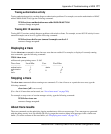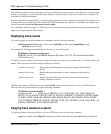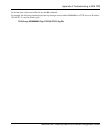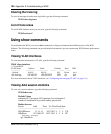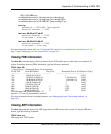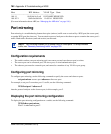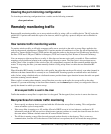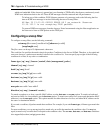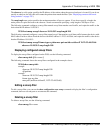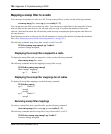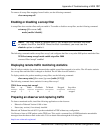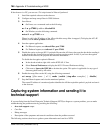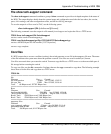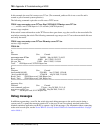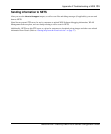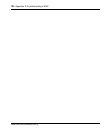
Appendix A:Troubleshooting a WSS 785
Nortel WLAN—Security Switch 2300 Series Configuration Guide
The observer ip-addr option specifies the IP address of the station where the protocol analyzer is located. If you do not
specify an observer, the AP radio still counts the packets that match the filter. (See “Displaying remote traffic moni-
toring statistics” on page 787.)
The snap-length num option specifies the maximum number of bytes to capture. If you do not specify a length, the
entire packet is copied and sent to the observer. Nortel recommends specifying a snap length of 100 bytes or less.
The following command configures a snoop filter named snoop1 that matches on all traffic, and copies the traffic to the
device that has IP address 10.10.30.2:
WSS# set snoop snoop1 observer 10.10.30.2 snap-length 100
The following command configures a snoop filter named snoop2 that matches on all data traffic between the device with
MAC address aa:bb:cc:dd:ee:ff and the device with MAC address 11:22:33:44:55:66, and copies the traffic to the device
that has IP address 10.10.30.3:
WSS# set snoop snoop2 frame-type eq data mac-pair aa:bb:cc:dd:ee:ff 11:22:33:44:55:66
observer 10.10.30.3 snap-length 100
Displaying configured snoop filters
To display the snoop filters configured on the WSS, use the following command:
show snoop info [filter-name]
The following command shows the snoop filters configured in the examples above:
WSS# show snoop info
snoop1:
observer 10.10.30.2 snap-length 100
all packets
snoop2:
observer 10.10.30.3 snap-length 100
frame-type eq data
mac-pair (aa:bb:cc:dd:ee:ff, 11:22:33:44:55:66)
Editing a snoop filter
To edit a snoop filter, you can use the show configuration area snoop command to display the filter’s configuration
command, then use cut-and-paste to reconstruct the command.
Deleting a snoop filter
To delete a snoop filter, use the following command:
clear snoop filter-name



